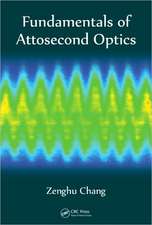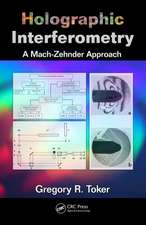Laser Modeling: A Numerical Approach with Algebra and Calculus
Autor Mark Steven Cseleen Limba Engleză Hardback – 8 apr 2014
- Explains how to formulate an accurate gain threshold equation as well as determine small-signal gain
- Discusses gain saturation and introduces a novel pass-by-pass model for rapid implementation of "what if?" scenarios
- Outlines the calculus-based Rigrod approach in a simplified manner to aid in comprehension
- Considers thermal effects on solid-state lasers and other lasers with new and efficient quasi-three-level materials
- Demonstrates how the convolution method is used to predict the effect of temperature drift on a DPSS system
- Describes the technique and technology of Q-switching and provides a simple model for predicting output power
- Addresses non-linear optics and supplies a simple model for calculating optimal crystal length
- Examines common laser systems, answering basic design questions and summarizing parameters
- Includes downloadable Microsoft® Excel™ spreadsheets, allowing models to be customized for specific lasers
Preț: 1099.43 lei
Preț vechi: 1480.32 lei
-26% Nou
Puncte Express: 1649
Preț estimativ în valută:
210.40€ • 218.85$ • 173.70£
210.40€ • 218.85$ • 173.70£
Carte tipărită la comandă
Livrare economică 14-28 aprilie
Preluare comenzi: 021 569.72.76
Specificații
ISBN-13: 9781466582507
ISBN-10: 1466582502
Pagini: 274
Ilustrații: 157 black & white illustrations, 18 black & white tables
Dimensiuni: 156 x 234 x 23 mm
Greutate: 0.52 kg
Ediția:1
Editura: CRC Press
Colecția CRC Press
ISBN-10: 1466582502
Pagini: 274
Ilustrații: 157 black & white illustrations, 18 black & white tables
Dimensiuni: 156 x 234 x 23 mm
Greutate: 0.52 kg
Ediția:1
Editura: CRC Press
Colecția CRC Press
Cuprins
Basic Laser Processes. Threshold Gain. Gain Saturation. Analytical Solutions. Thermal Issues. Generating Massive Inversions: Q-Switching. Non-Linear Optics. Common Lasers and Parameters.
Recenzii
"One of Marc Csele's key strengths is his clear and illustrative style; he grounds the material in everyday words and examples. …the choice and order of the chapters brings the reader along gradually from basic knowledge to practical application in a logical and comfortable way."
––Marc Nantel, Niagara College, Niagara Falls, Ontario, Canada
"This is a textbook, written so as to be accessible to undergraduate students. The aim is to introduce the reader to laser science, parallel with the presentation of basic mathematical models used for the description of lasers of various types, and of basic physical properties of those lasers. Accordingly, the mathematical models are classified as algebra-based and calculus-based ones. Particular chapters are dealing with fundamental topics, such as the lasing threshold, gain saturation, thermal effects, Q-switching, and some basic effects of nonlinear optics. Many particular examples are included, which may be used as teaching material. The book also contains a lot of practical material about basic types of existing lasers, such as gas lasers, semiconductor lasers, and solid-state ones."
––Boris A. Malomed (Tel Aviv), from Zentralblatt MATH 1320 – 1
––Marc Nantel, Niagara College, Niagara Falls, Ontario, Canada
"This is a textbook, written so as to be accessible to undergraduate students. The aim is to introduce the reader to laser science, parallel with the presentation of basic mathematical models used for the description of lasers of various types, and of basic physical properties of those lasers. Accordingly, the mathematical models are classified as algebra-based and calculus-based ones. Particular chapters are dealing with fundamental topics, such as the lasing threshold, gain saturation, thermal effects, Q-switching, and some basic effects of nonlinear optics. Many particular examples are included, which may be used as teaching material. The book also contains a lot of practical material about basic types of existing lasers, such as gas lasers, semiconductor lasers, and solid-state ones."
––Boris A. Malomed (Tel Aviv), from Zentralblatt MATH 1320 – 1
Notă biografică
Mark Steven Csele is a full-time professor at Niagara College, Welland, Ontario, Canada. A physicist and professional engineer, he has taught for over 20 years at levels ranging from two-year technician to four-year undergraduate. Currently, he teaches photonics at Niagara College, which features an array of dedicated laboratories hosting a variety of laser systems. He has authored a previous book on fundamental laser concepts as well as several articles in magazines and trade encyclopedias.
Descriere
Don’t let the mathematical rigor of solutions get in the way of understanding the concepts. Complete with downloadable spreadsheets, this novel text presents algebraic models and traditional calculus-based methods in tandem to make concepts easier to digest. Each technique is introduced alongside a practical, solved example based on a commercial laser. Chapters address gain saturation, thermal effects on solid-state lasers, Q-switching, non-linear optics, and more. Laser theory is covered in an accessible way that can be applied immediately, and numerically, to real laser systems.








